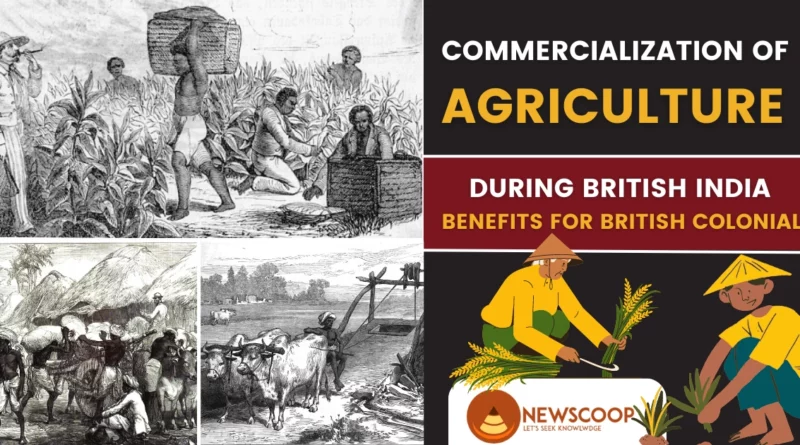Commercialization of Agriculture: British India
The commercialization of agriculture in British India marked a significant turning point in the country’s agrarian economy. The colonial administration’s policies and economic interests led to the transformation of traditional subsistence farming into a profit-oriented commercial enterprise.
This article explores the key aspects of this process, highlighting the impact on landownership, crops, infrastructure, and the lives of Indian farmers.
What is the Commercialization of Agriculture?
Commercialization of agriculture refers to the process of transforming traditional subsistence farming practices into profit-oriented agricultural enterprises. It involves shifting the focus from producing primarily for self-sufficiency and local consumption to producing crops or livestock for sale in domestic or international markets.
The primary objective of commercial agriculture is to generate income and maximize profits by engaging in large-scale production, utilizing modern technologies, and responding to market demands.
Commercialization of agriculture typically involves several key aspects:
- Crop Selection: Cultivation of cash crops for sale in the market.
- Increased Scale: Large-scale production and expansion of land holdings.
- Market-Oriented Approach: Decision-making based on market demand, pricing, and consumer preferences.
- Technological Advancements: Adoption of modern farming techniques, machinery, and technologies.
- Specialization and Division of Labor: Focus on specific crops or livestock to maximize efficiency and quality.
Causes of Commercialization of Agriculture in British India
The commercialization of agriculture in British India was driven by various factors and causes. Here are some key causes that contributed to this process:
1. British Colonial Policies: The policies implemented by the British colonial administration played a significant role in promoting the commercialization of agriculture. The British sought to extract economic benefits from India, and transforming agriculture into a profit-oriented enterprise served their interests. Policies such as the Permanent Settlement Act of 1793 and the introduction of the zamindari system consolidated land ownership, leading to the concentration of agricultural land in the hands of a few landlords.
2. Expansion of British Industrialization: The industrial revolution in Britain created a demand for raw materials and agricultural products. British industrialists needed a reliable and steady supply of commodities such as cotton, jute, tea, and indigo from India. The commercialization of agriculture was aimed at meeting this demand and ensuring a steady flow of agricultural products for export to British industries.
3. Introduction of Cash Crops: The British encouraged the cultivation of cash crops that had high demand in the global market. Indigo, opium, cotton, jute, tea, and coffee were introduced and promoted as commercial crops. Farmers were incentivized or coerced into shifting from subsistence farming to the cultivation of these cash crops, allowing the British to profit from the export of these commodities.
4. Infrastructure Development: The British colonial administration invested in the development of infrastructure, including transportation and irrigation systems. The construction of railways, canals, and roads facilitated the movement of agricultural products from farms to markets. Irrigation projects were undertaken to ensure a consistent water supply for commercial crops. These infrastructure developments supported the growth of commercial agriculture and integration into the global market.
5. Market Forces and Profit Motive: The shift towards commercial agriculture was driven by market forces and profit motives. British policies and economic interests created an environment that encouraged farmers to produce for the market rather than for subsistence. Farmers were motivated to maximize their profits by focusing on crops with high market demand and adapting their farming practices to cater to commercial requirements.
6. Changes in Land Tenure Systems: The introduction of new land tenure systems, such as the Zamindari system, significantly impacted agriculture. Landownership became concentrated in the hands of landlords, while many small farmers lost their lands or became tenants. This change in landownership patterns created a conducive environment for commercial agriculture, as large landholders were more likely to invest in commercial production.
7. Technological Advancements: The British introduced modern agricultural technologies and techniques, such as improved seeds, mechanization, and chemical fertilizers. These advancements increased productivity and efficiency, making commercial agriculture more viable and profitable.
Impact of Commercialization of Agriculture
Positive Impacts:
- Growth of commercial crops for export and meeting the demand of British industries.
- Development of transportation and irrigation infrastructure.
- Economic benefits for British colonial administration.
Negative Impacts:
- The decline in traditional food crop production led to food scarcity.
- Disruption of farmer livelihoods and displacement of small farmers.
- The exploitation of farmers by intermediaries and middlemen.
- Widening socioeconomic inequalities.
- Unequal distribution of benefits, primarily benefiting the British administration.
Movements against the Commercialization of Agriculture
Here is a list of some notable resistance movements related to the commercialization of agriculture in British India:
- Indigo Revolt (1859-1860): Peasant uprising against exploitative indigo cultivation in Bengal.
- Deccan Riots (1875): Protests by farmers in the Deccan region against the exploitative agrarian policies and revenue system.
- Kisan Sabha Movement (1920s-1940s): A peasant movement led by the All India Kisan Sabha, advocating for the rights of farmers and addressing issues such as landlessness and indebtedness.
- Bardoli Satyagraha (1928): Peasant resistance led by Sardar Vallabhbhai Patel in Bardoli, Gujarat, against high land taxes imposed by the British.
- Tebhaga Movement (1946-1947): Peasant movement in Bengal demanding two-thirds share of crops from the landlords instead of the traditional half-share.
- Telangana Peasant Armed Struggle (1946-1951): A violent uprising of peasants and agricultural laborers in the Telangana region against landlords and the feudal system.
- Naxalite Movement (Late 1960s-present): Maoist-inspired revolutionary movement with agrarian issues at its core, aiming to address land reforms, redistribution, and social justice.
These movements represented the resistance and struggle of Indian farmers against exploitative agricultural practices and oppressive colonial policies during the period of commercialization of agriculture in British India.
Also Read: Feminization of Agriculture in India
Conclusion
In conclusion, the commercialization of agriculture in British India had significant and varied impacts. While it led to the growth of cash crops and infrastructure development, it also resulted in a decline in traditional food crops, exploitation of farmers, and widened socioeconomic inequalities. Resistance movements emerged to challenge these injustices and fight for the rights of farmers.
Further, the commercialization of agriculture shaped the agrarian sector and left a lasting legacy on rural societies, highlighting the need for sustainable and equitable agricultural practices today.
Thank You!

